Are you ready to impress your friends and family with your dog’s incredible trick skills? Teaching your dog Fun Tricks To Train Your Dog is an excellent way to challenge their minds, strengthen your bond, and showcase their intelligence. Once mastered, these tricks are not only entertaining but can also contribute to earning prestigious AKC Trick Dog titles, highlighting your dog’s capabilities.
Embarking on this trick training journey requires a few essential tools: patience, consistent time commitment, irresistible dog treats, and engaging toys if your dog is highly motivated by play. For those who utilize a clicker while training, ensure you have one readily available to precisely mark the moment your dog performs the desired behavior. Additionally, selecting a quiet, distraction-free environment will significantly enhance your training sessions, allowing your dog to focus fully on learning these exciting new skills. These fun tricks to train your dog provide mental stimulation and build confidence, making training an enjoyable experience for both of you. You might discover some new things to teach your dog that go beyond basic obedience, leading to a more enriched life for your furry friend.
How to Teach Your Dog to Catch
Teaching your dog to catch is a highly rewarding and interactive trick, perfect for engaging their natural instincts. To begin, position yourself directly in front of your dog and capture their attention with a delicious treat. Gently toss the treat with an underhanded motion, aiming for their mouth. If your dog successfully catches the treat, lavish them with enthusiastic praise. If they miss, try to quickly intercept the treat before they can eat it from the floor, then reset and try again.
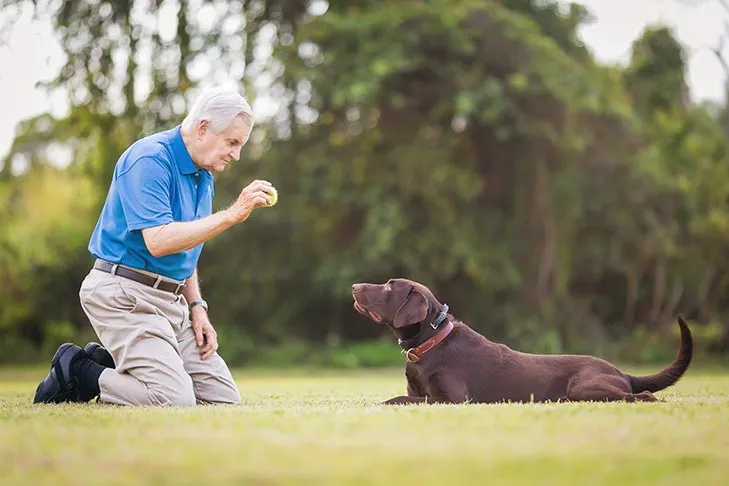 Labrador Retriever catching a tennis ball during a fun trick training session
Labrador Retriever catching a tennis ball during a fun trick training session
Repeat this exercise a couple of times during each short training session to build consistency. Once your dog reliably catches tossed treats, you can gradually transition to gently tossing lightweight toys they enjoy. Each successful catch of a toy should be met with abundant praise, immediately followed by a treat to reinforce the positive behavior. Mastering this trick builds coordination and makes playtime even more dynamic.
How to Teach “Under the Bridge”
“Under the Bridge” is a charming trick where your dog crawls underneath your raised knees, forming a “bridge.” This trick requires your dog to lower their body and navigate a confined space, building their body awareness and confidence. Ensure you have high-value treats or a favorite toy to keep your dog motivated.
Begin by sitting on the floor with your knees bent and raised, creating a triangular tunnel. Position your dog on one side of your body. Hold the treat or toy in your hand on the opposite side, reaching it under your legs to allow your dog to sniff it. Slowly lower the lure towards the ground, guiding it under your legs. As your dog follows the enticing lure, they will naturally lower their body and crawl through the tunnel you’ve created. The moment they emerge on the other side, shower them with praise and deliver the treat or toy.
After a few successful repetitions, start introducing a verbal cue of your choice, such as “under” or “bridge,” just as they begin to move. Once your dog consistently performs this trick with the lure and verbal cue, you can gradually fade out the lure. Eventually, you should be able to simply give the verbal cue, and your dog will crawl under your legs, earning immediate praise and a treat upon completion. This is one of many good tricks to train your dog that helps improve their flexibility and focus.
How to Teach “Speak”
Teaching your dog to “speak” on command is a popular and engaging trick, often achieved through a method called “capturing.” Capturing involves marking a naturally occurring behavior and then associating a cue with it over time. To teach your dog to speak, have a handful of treats ready.
Whenever your dog naturally barks out of excitement, attention-seeking, or in response to a doorbell, immediately mark that barking with a verbal cue of your choice (like “speak,” “talk,” or “voice”) and promptly give them a treat. If you’re using a clicker, the clicker’s precise sound makes it incredibly easy to mark the exact moment your dog barks, helping them quickly understand precisely what behavior you are rewarding.
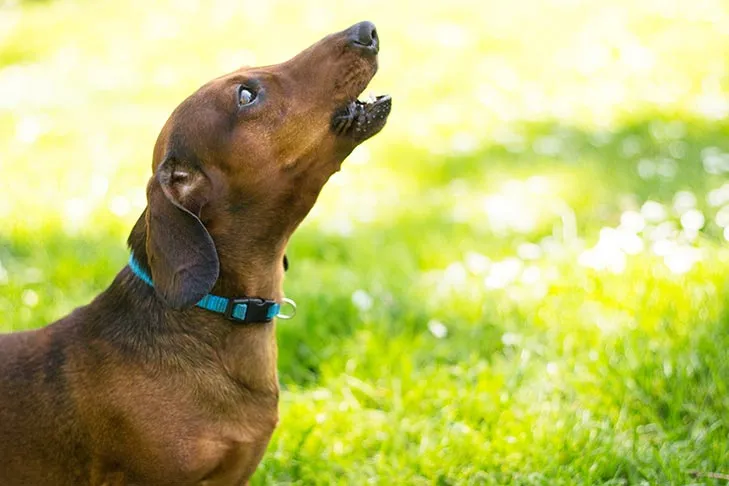 Dachshund barking excitedly, learning the 'speak' command
Dachshund barking excitedly, learning the 'speak' command
After several repetitions of consistently marking and rewarding, your dog will begin to grasp the concept that you are looking for them to bark. To prevent your dog from barking excessively or at inappropriate times, it is crucial to only reward them when they bark specifically in response to your given cue, once they understand the trick. This precise reinforcement helps manage the behavior effectively.
How to Teach Leg Weaves
Leg weaves are a dynamic and impressive trick, where your dog gracefully weaves through your legs in a figure-eight pattern. Start in a safe, open area without a leash to prevent tangling. Stand with your legs wide apart and your dog positioned in front of you. Hold a treat in one hand, positioned behind your legs. This allows you to lure your dog through and around your legs naturally, rather than pushing the treat from the front. Bend your knees slightly and use the treat to guide your dog to walk between your legs. As your dog passes through, praise them enthusiastically and deliver the treat.
Once your dog is comfortable with this initial movement, use another treat to guide them through your legs and then around one of your legs until they return to their starting position in front of you. As you lure, you can allow your dog to lick or gently nibble the treat to maintain their focus and position. When they complete the full movement and return to the front, offer praise and a treat.
After your dog confidently follows the treat through your legs and around one side, repeat the same steps to teach them to navigate through and around your other leg. When your dog consistently follows the lure through your legs and around both legs individually, it’s time to connect the movements into a fluid figure-eight pattern.
Begin by luring your dog between your legs and around your right leg, then immediately around your left leg, before rewarding them with a treat. Next, you can gradually fade out the physical treat lure by using an empty hand to guide them. Once your dog can weave between your legs by following your empty hand, introduce your chosen verbal cue, such as “weave” or “legs.” With continued repetitions, you can phase out the empty-handed lure entirely. Your dog will then begin to recognize your bending-knee body language as the physical cue for the trick. Once they’ve mastered leg weaving while you’re stationary, you can advance to teaching them to leg weave while you walk forward. Start by taking large, slow steps as you cue your dog to weave. As you introduce movement, reintroduce the treat lure temporarily to help build your dog’s confidence. With practice, you can phase out the lure again and gradually increase your walking speed with smaller steps to polish this impressive trick.
How to Teach Your Dog to Shake Hands
Teaching your dog to “shake hands” or “give paw” is a classic and endearing trick that many pet owners cherish. Start by holding your hand out to your dog, palm open and facing upwards. Initially, your dog might lick or sniff your hand; ignore these behaviors. The moment your dog paws at your hand, immediately mark that specific action with praise or a click, and then give them a treat. Continue repeating this process until your dog consistently paws at your outstretched hand.
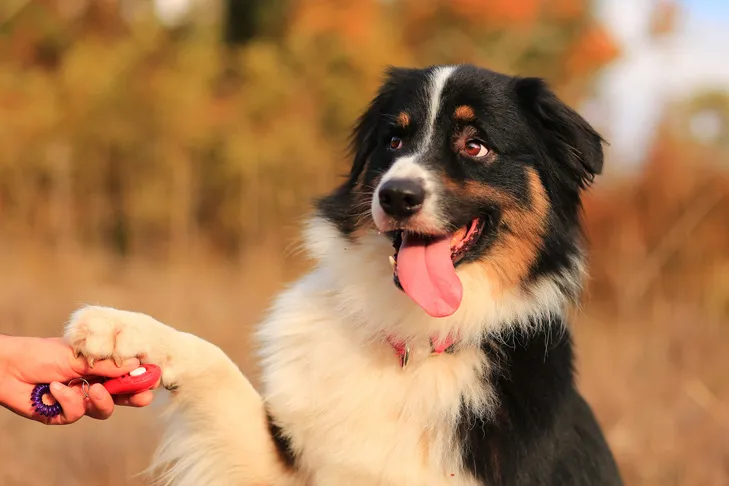 Australian Shepherd giving a paw to shake hands during dog trick training
Australian Shepherd giving a paw to shake hands during dog trick training
Next, you can begin to increase the duration for which your dog’s paw rests on your hand. To do this, wait a second or two longer before clicking or praising and then rewarding them. Initially, aim for just a second or two of their paw on your hand. Gradually extend this duration as your dog understands what is expected.
Once your dog reliably places their paw on your hand and waits patiently for the reward, introduce a verbal cue like “shake,” “paw,” or “hello.” At this stage, you’re also ready to flatten your hand and hold it vertically (perhaps with a treat concealed within it) in a motion similar to shaking a person’s hand. Start introducing a gentle, upward and downward movement with your hand just before treating your dog. This helps them associate the physical gesture with the action. Mastering these tricks you can teach your dog builds a strong foundation for more complex behaviors.
How to Teach “Yes” and “No”
This clever trick gives the appearance that your dog can answer “yes” or “no” to your questions by nodding or shaking their head. To teach your dog to “say yes,” hold a high-value treat in a closed fist (or use any simple, distinct hand signal you prefer). Slowly move the hand holding the treat lure upwards and downwards, encouraging your dog to follow the lure with their nose, which will result in a nodding motion of their head. As soon as they nod, reward your dog with the treat.
Once your dog consistently follows your closed fist up and down, try performing the motion without a treat visibly in your hand. When your dog nods their head in response, praise them immediately and then give them a treat from your other hand. With consistent practice, the closed fist signal will become the physical cue for your dog to nod their head, and you can gradually phase out the need to move your fist up and down.
To teach your dog to “say no,” you’ll use a similar, systematic approach but with a different hand signal. For instance, you might use a closed fist with your pointer finger extended upwards. To encourage them to shake their head, move your chosen hand signal slowly from side to side. As your dog follows your hand with their nose, their head will naturally move from side to side, mimicking a head shake. When your dog moves their head to follow your hand, immediately praise and treat them. With dedicated practice, the specific finger-up hand signal will become the physical cue for your dog to shake their head.
How to Teach Your Dog to Bow
The “bow” is an elegant and beneficial trick that encourages stretching and builds core strength in your dog. To teach this trick, begin with your dog standing directly in front of you. Capture their attention with a treat held in your hand. Slowly lure their nose downwards, between their front legs, and then back towards their chest and belly. As your dog follows the treat lure, they will naturally lower their front body while keeping their hindquarters raised, moving into the classic bow position. Praise your dog enthusiastically and deliver the treat. Immediately after, toss another treat a short distance away to encourage them to stand up and move, preventing them from collapsing into a “down” position. Repeat this over several short practice sessions.
While luring and guiding between the dog’s front legs works for many dogs, some may struggle and instead collapse into a full “down” position. If this occurs, Penny Leigh, CPDT-KA, Director of the AKC GoodDog Helpline (GDH), suggests a helpful modification: try placing a hand or even just a finger lightly on your dog’s stomach, just below the loin. This subtle pressure can cue them that you are not asking for a complete “down,” helping them understand the distinction for the bow.
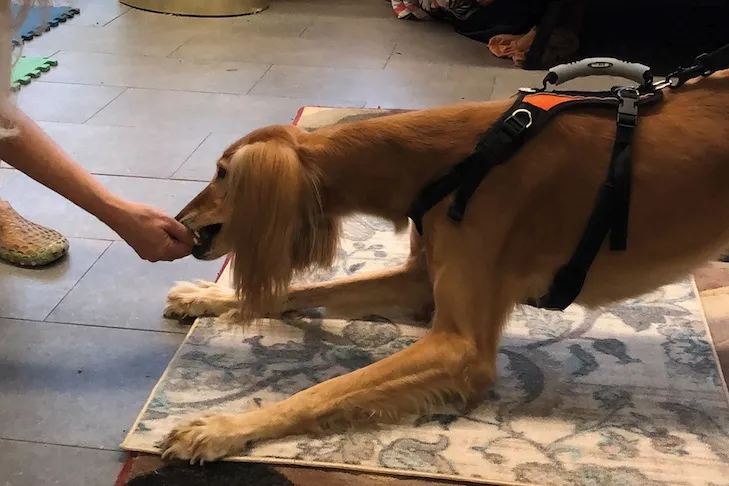 Small dog performing the 'bow' trick, stretching its front legs and lowering its chest
Small dog performing the 'bow' trick, stretching its front legs and lowering its chest
Once your dog consistently follows the food lure into the bow position, begin to use an empty hand as your lure. Treat your dog after they have successfully transitioned into the bow. When your dog reliably follows the empty-hand lure, you can start introducing a verbal cue of your choice, such as “bow” or “fancy.” With consistent practice, your dog will develop the strength and coordination to hold the bow longer. Eventually, you can phase out your physical hand lure, and over time, you can even evolve the physical cue for this trick to involve you bowing or curtsying yourself, making it a truly interactive and fun trick to teach your puppy or adult dog.
How to Teach Your Dog to Make a Circle (Spin)
Teaching your dog to “spin” or “make a circle” is a lively and enjoyable trick that adds flair to their repertoire of commands. To start, get your dog’s attention with a high-value treat or a favorite toy. Hold the lure just above your dog’s nose and slowly move your hand in a large, smooth circle. As your dog follows the treat or toy with their nose, they will naturally walk in a circle. As soon as they complete the circle, praise them enthusiastically and deliver the treat.
After a few successful repetitions, when your dog consistently follows the lure in a circular motion, you can introduce your chosen verbal cue, such as “spin,” “twirl,” or “around.” Next, use the identical technique to lure your dog in a spinning motion in the opposite direction. Once your dog consistently follows your lure to spin the other way, add in a distinct verbal cue for that direction (e.g., “other way” or “reverse spin,” or simply “around” with a different hand gesture if preferred).
When your dog reliably follows your verbal cue in both directions, you can begin to use the circular hand motion without a treat in your hand, while simultaneously giving your verbal cue. The moment your dog spins in response, offer praise and a treat. This helps them understand the visual and verbal cues independently of the food lure. These fun tricks to do with your dog build agility and responsiveness.
How to Teach Your Dog to Play Peekaboo
The “Peekaboo” trick, also known as “middle,” is a practical and adorable skill where your dog comes and positions themselves between your legs, often facing the same direction as you. This trick can be incredibly useful in crowded spaces or when you need to keep your dog close and secure.
To teach your dog Peekaboo, begin by standing in front of your dog, with both of you facing the same direction. Hold a treat in your hand and use it to get their attention. Lure your dog forward, encouraging them to walk through your legs. The moment your dog successfully comes between your legs, offer immediate praise and a treat.
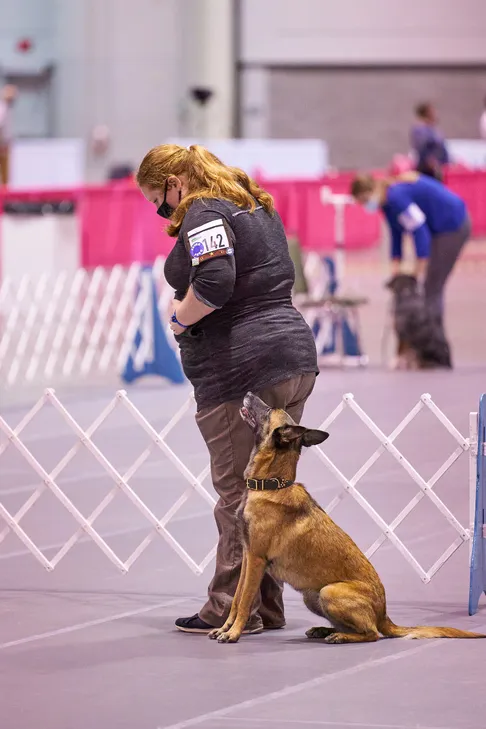 Dog peeking between owner's legs, practicing the 'peekaboo' trick
Dog peeking between owner's legs, practicing the 'peekaboo' trick
After a few successful repetitions, you can introduce a verbal cue of your choice, such as “middle” or “peekaboo,” just as your dog begins to move between your legs. Once your dog is in position between your legs, use your chosen release cue (if you have one) or simply toss a treat a short distance away to encourage them to move out of position, allowing you to reset for another practice. As you continue to practice, you will gradually be able to fade out the need to lure your dog forward with a treat, and your dog will respond directly to the verbal cue to come into the Peekaboo position. This is another example of fun tricks to train your dog that enhances their focus and proximity control.
Conclusion
Teaching your dog these fun tricks to train your dog offers a multitude of benefits, from enhancing their cognitive abilities and physical coordination to deepening the bond you share. Each trick, from the simple catch to the intricate leg weave, provides a unique opportunity for positive reinforcement training, building confidence, and fostering a strong, positive relationship between you and your canine companion. Remember, consistency, patience, and positive reinforcement are the cornerstones of successful dog training. Don’t be afraid to experiment with different lures and rewards to find what motivates your dog best. The journey of teaching new tricks is as rewarding as the final performance. So, gather your treats, find a quiet spot, and start creating joyful memories while transforming your dog into a trick-savvy superstar!
References
- AKC Staff. (n.d.). Why Trick Training Is Good for Dogs. American Kennel Club. Retrieved from https://www.akc.org/products-services/training-programs/canine-good-citizen/articles/why-trick-training-is-good-for-dogs/
- AKC Staff. (n.d.). AKC Trick Dog Titles. American Kennel Club. Retrieved from https://www.akc.org/sports/trick-dog/
- AKC Staff. (n.d.). Dog Training Treats. American Kennel Club. Retrieved from https://www.akc.org/expert-advice/training/dog-training-treats/
- AKC Staff. (n.d.). What Motivates Your Dog to Work?. American Kennel Club. Retrieved from https://www.akc.org/expert-advice/training/what-motivates-your-dog-to-work/
- AKC Staff. (n.d.). Clicker Training Your Dog: Mark and Reward. American Kennel Club. Retrieved from https://www.akc.org/expert-advice/training/clicker-training-your-dog-mark-and-reward/
- Leigh, P. (n.d.). AKC GoodDog Helpline. American Kennel Club.
